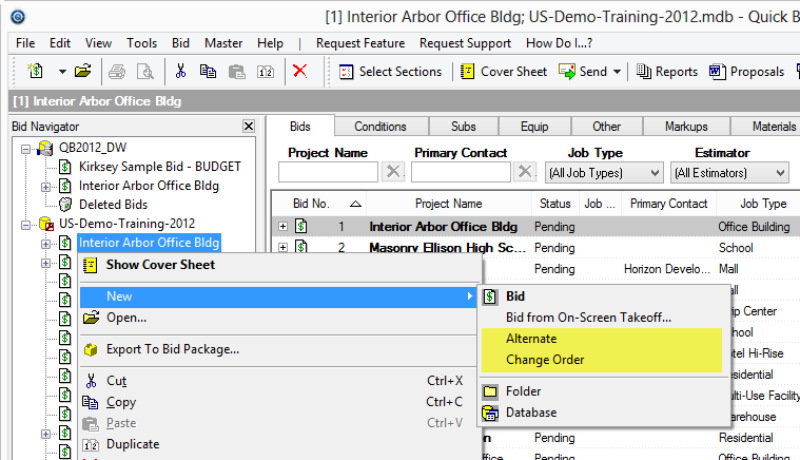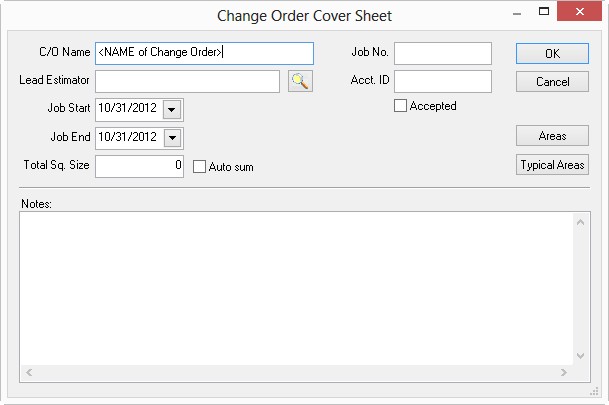Alternates and Change Orders are "child" or "sub" bids (not Subcontractor, but subordinate) that are added to a Base Bid to provide options before the contract (Alternates) or additional work/changes to the original scope (Change Orders).
Alternates
Alternates are options for a Bid priced separately from the base Bid. The owner/customer elects to accept or reject the proposed alternate. Accepted alternates add money to or deduct money from the price of the base Bid. Alternates are priced during the bidding stage of a project. Because Alternates are options for the base Bid, they use the same Bid Items (material and labor costs) and Payroll Settings as the base Bid, although you can configure Markups and Indirect Expenses separately for Alternates.
The following rules applies to Alternates:
- Alternates use the same Payroll Settings information as the base Bid
- Alternates use the same Material pricing as the base Bid
If the price of a Material changes in the base Bid, that change is reflected in the Alternate. The same applies for Payroll Setting. The reverse is also true: changes to Material or Labor pricing within an Alternate affect the base Bid.
Change Orders
Change Orders are changes in the scope of work for the base Bid. Change Orders are typically priced after a project’s base Bid (and perhaps, Accepted Alternates) has been awarded. A Change Order is a change to the contract. As the name implies, Change Orders reflect changes to some aspect of the base Bid. Accepted Change Order pricing is tracked separately from the base Bid pricing, as such, Change Orders can have different payroll, material and labor pricing, section markups and indirect expense information. When a Change Order is accepted into a base Bid, the information is not merged into the base Bid, labor or material reports. Information for the Change Order is, however, included on the base Bid's Bid Summary Report.
The following rules applies to Change Orders:
- Change Orders can use unique Payroll Settings different than the base Bid
- Change Orders can use different Material pricing than the base Bid
- Change Orders use different Section Markups than the base Bid
- Change Orders use different Indirect Expenses (Stocking, Cleanup, Supervision and Per Diem) than the base Bid
Changes to the Base Bid do not affect the total of Change Orders and changes to Change Orders do not affect the total of the Base Bid. Change orders store their own Material and Labor information. This information is based on the Base Bid pricing, although, if an Item is not used in the base Bid, the program pulls from the master Items table. Change Orders always look to the base Bid for Items before pulling from the master list.
Adding an Alternate or Change Order
Select the Bid (in the Bid Navigator or Bid List) under which you want to create the child Bid.
Click File > New > Alternate or Change Order...

Click Alternate or Change Order - either the Alternate or Change Order Cover Sheet appears.


Fill in each fields as required - each field is detailed below:
| Field or Control | What it does/How it is used... |
|---|
| Name | Enter a name for the Alternate or Change Order - limit: 75 characters. Required field. Names must not include Special Characters such as #, % or and -, any of the '<Shift> + Number' combinations or any brackets or back/forward slashes; only standard alpha-numeric English characters should be used. |
| Job No. | Can be a number or an alpha-numeric entry. |
| Acct. ID | Used to identify different Accounts (customers) for whom an estimator creates bids. |
Submitted
(Alternates only) | This field populates with the current date. To select another date, click the arrow and select a date from the calendar, or type in a date. |
Lead Estimator
(Change Orders only) | Select the Lead Estimator for the Change Order (because Alternates are an option for the Base Bid, the Lead Estimator cannot be changed in an Alternate). |
Job Start
(Change Orders only) | This field populates with the current date. To select another date, click the arrow and select a date from the calendar, or type in a date (because Alternates are an option for the Base Bid, the Job Start/End dates cannot be changed in an Alternate). |
Job End
(Change Orders only) | This field populates with the current date. To select another date, click the arrow and select a date from the calendar, or type in a date (because Alternates are an option for the Base Bid, the Job Start/End dates cannot be changed in an Alternate). |
Total Sq. Size
(Change Orders only) | This is an optional entry that accepts the square footage of a building or site area and is used in the Bid Analysis report to establish cost ratios. (because Alternates are an option for the Base Bid, the Total Sq. Size cannot be changed in an Alternate). |
Auto Sum
(Change Orders only) | Place a check in this box to have Quick Bid automatically sum the cumulative total of all Bid Areas. Auto sum does not include indented areas - only top level entries in the Bid Areas grid. See Related articles for more information on setting up and using areas. |
Areas
(Change Orders only) | Change Order specific Areas may be added to a Bid (because Alternates are an option for the Base Bid, Bid Areas and Typical Areas cannot be changed) in an Alternate. |
Typical Areas
(Change Orders only) | Change Order specific Typical Areas may be added to a Bid (because Alternates are an option for the Base Bid, Bid Areas and Typical Areas cannot be changed in an Alternate). |
| Accepted | Accepted Alternates will add costs to, or subtract costs from, the price of the Base Bid. Alternates are priced during the bidding stage of a project. Accepted Change Order pricing is tracked separately from the Base Bid pricing. A Change Order is a change to the contract. Accepting a Change Order affects the overall Selling Price of the Project, but the costs are reported separately. |
| Notes | Document important information about the Alternate or Change Order here. |
Click OK - the Alternate or Change Order is added and the Conditions Tab, for the child bid, is displayed.
Build Conditions for the Child Bid just like the Base Bid (or copy Conditions from the Base Bid to this child Bid or even from another Bid or another child Bid). See Related articles for more information.
Notes
Alternates and Change Orders appear directly below the Base Bids on the Bids Tab and in the Markups Projects/Sections grid. If a Child Bid is not visible, locate the Bid in the Bid Navigator and click the expand button  to the left of the base Bid name.
to the left of the base Bid name.
When creating Change Orders and Alternates, limit the length of the "No." field to 25 characters or less.
Open the Alternate or Change Order Cover Sheet dialog to change acceptance or any other field by double-clicking the child Bid in the Bid Navigator. Toggle between Accepted and Not Accepted on the Markups Tab by placing a check mark next to the Child Bid's name.
You can copy and paste Conditions or Condition Details from the Base Bid into the child bid. See Related Articles for details.
